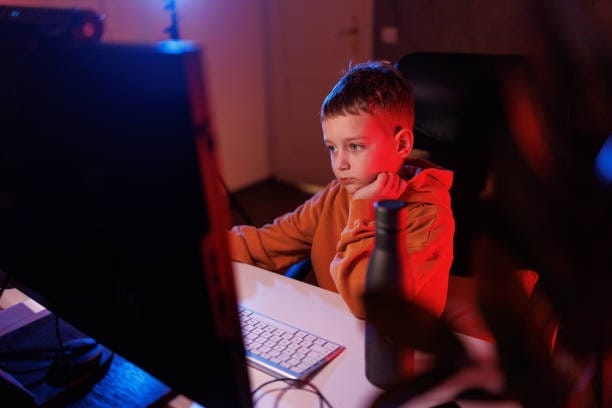The world our children are growing up in is not the same as the one we knew. Once upon a time, “play” meant bicycles, chalk on sidewalks, and hide-and-seek until the streetlights came on. Today, children carry entire universes in their pockets — phones, tablets, laptops that open gateways to infinite worlds. Those worlds can be magical, filled with learning and creativity. But they can also be dangerous, deceptive, and overwhelming.
As parents, we’re faced with a challenge no generation before us has ever encountered: how to protect our children not just on the streets, but in the invisible cities of the internet. We can’t physically walk beside them online, but we can prepare them to navigate it with wisdom, resilience, and courage.
This is more than just about safety. It’s about trust, understanding, and raising children who can thrive in a digital age without losing themselves in it.
The Hidden Dangers Behind the Screen
When a child picks up a device, they’re stepping into a vast ocean of information, people, and experiences. Some of it is enlightening — an online museum tour, a math tutorial, a heartfelt conversation with a faraway grandparent. But lurking beneath the surface are strong currents: cyberbullying, predators, inappropriate content, identity theft, and the subtle erosion of mental health through comparison and overexposure.
One of the most insidious dangers is how normalized risky behavior can become online. On social media, strangers can pose as peers, coaxing personal information out of children. Gaming platforms, with their immersive environments, can disguise manipulative players behind friendly avatars. Even YouTube, with its seemingly innocent videos, can slide a child from a cartoon into content you’d never want them to see.
The challenge is not to terrify our children into avoiding the internet altogether — that would be unrealistic and, frankly, unfair in a digital society. Instead, it’s to teach them to see the red flags, to understand that not every friend request is friendly, and to know that they can always come to us when something feels wrong.
Why Trust Is the First Line of Defense
Before we even start talking about parental controls, monitoring software, or digital rules, we have to talk about trust. A child who fears punishment is far less likely to come forward if they encounter something unsettling online. If we want to protect our kids, we need open doors, not locked ones.
This means having conversations early — long before your child even owns a device. It means explaining that the online world has strangers, much like the real one, and that sometimes those strangers pretend to be kind. It means sharing, in age-appropriate ways, the reality that photos, messages, and videos online can be copied, altered, and spread beyond their control.
When your child knows that they can tell you anything without fear of instant judgment or overreaction, you create a safety net that no app can replace. The most powerful internet filter is still a child who feels safe telling the truth.
Setting Boundaries Without Building Walls
Children need freedom to explore, but they also need fences to keep them from wandering into danger. The art of online safety lies in balancing those two needs. A home without any digital boundaries risks letting the internet raise the child; a home with overly strict controls risks rebellion or secretive behavior.
Boundaries start with simple routines. Devices stay out of bedrooms at night, because the combination of late hours, fatigue, and unmonitored access is a recipe for trouble. Screen time has a rhythm — not just for preventing overuse, but for teaching self-regulation. Family activities should sometimes be entirely device-free, not as a punishment, but as a celebration of life beyond the screen.
The rules should grow with the child. A seven-year-old may need tightly managed access to only a few safe apps; a sixteen-year-old needs more room to develop independence, but still with guidance. Boundaries aren’t static — they’re a conversation that evolves.
Understanding the Social Media Universe
Social media is one of the most influential forces shaping young minds today. It’s where friendships are made and broken, where trends are born, where the smallest moment can be broadcast to hundreds or thousands of people. It’s also a place where self-worth can get tangled up with likes and comments.
For parents, this means two things: we need to understand the platforms our children use, and we need to teach them the difference between real life and the filtered one they see online. That “perfect” photo might have been staged for hours. That happy update could be masking sadness.
Help your child develop a critical eye. Ask them how they think a post was created. Show them examples of photo editing. And perhaps most importantly, model healthy online behavior yourself — if you’re constantly checking your phone at the dinner table, they will learn that’s normal.
Gaming: More Than Just a Game
Online gaming has exploded into one of the largest social spaces for children. Games can foster teamwork, creativity, and problem-solving. But they also come with risks: anonymous chat features, in-game purchases, and the potential for addictive play patterns.
Many predators use gaming environments to initiate contact with children because the shared activity builds quick rapport. The anonymity of gaming usernames can make it hard to know who’s really on the other side of the conversation.
This doesn’t mean banning games outright, but it does mean staying informed. Play the game with your child sometimes. Ask who they’re playing with. Teach them to keep personal information private, even if a teammate seems friendly. And be aware of how the game’s design — its reward systems, its competitive ranking — can make it hard for a child to step away.
Privacy: The Currency of the Digital Age
In the online world, privacy isn’t just about keeping secrets — it’s about control. Every time a child posts a photo, fills out a profile, or signs up for a “free” service, they’re exchanging pieces of their personal information. That information can be used for marketing, manipulation, or worse.
Teaching privacy means showing your child how to recognize phishing attempts, how to create strong passwords, and why not every quiz or survey is as innocent as it seems. It means explaining that “delete” doesn’t always mean gone, and that screenshots are forever.
When children understand that their digital identity is valuable — and that it belongs to them — they’re more likely to think before they share.
Cyberbullying: The Invisible Playground Fight
Bullying has always existed, but the internet changes its shape. Online, bullies can follow a child home, invading the space that was once a refuge. Hurtful messages, public shaming, exclusion from group chats — these can have as deep an impact as any physical confrontation.
The first step in combating cyberbullying is awareness. Your child may not tell you if they’re being targeted, either out of shame or fear of losing their devices. Watch for changes in mood, reluctance to use certain apps, or sudden withdrawal from social activities.
If cyberbullying does happen, document everything. Save messages, take screenshots. Report the behavior to the platform, and if necessary, to school authorities or even law enforcement. But just as importantly, make sure your child knows they are not to blame. Your response in these moments shapes how they will handle online conflict for the rest of their lives.
Teaching Digital Citizenship
Keeping kids safe online isn’t only about defending them from harm — it’s also about guiding them toward being respectful, responsible digital citizens. This means teaching empathy in online interactions, encouraging them to think about how their words and actions affect others, and helping them understand that their digital footprint will follow them into adulthood.
Digital citizenship is about balance: consuming content and creating it, being entertained and being informed, connecting with friends and respecting boundaries. The more a child understands that their online behavior is part of their character, the more they will choose wisely even when no one is watching.
The Role of Technology in Protection
While trust and education are the core of online safety, technology can be a valuable ally. Parental control tools, safe search settings, and monitoring apps can provide a safety net. But these tools are not a substitute for conversation — they are an extension of it.
Filters can block harmful content, but they can’t explain why it’s harmful. Monitoring can alert you to trouble, but it can’t replace the empathy and guidance that help a child process what they’ve seen. The most effective strategy blends human guidance with technological support.
Preparing for the Future We Can’t Predict
The digital world evolves faster than any generation before has experienced. Apps rise and fall in popularity in months. Privacy settings change overnight. A platform safe for kids today could be dangerous tomorrow.
This means that more than memorizing rules, our children need adaptable skills: how to question, how to verify, how to pause before reacting. They need to know that they can always ask for help, and that learning about the online world is a lifelong process — for them, and for us.
As parents, we don’t need to know every app, every game, every trend. But we do need to know our children — how they think, what they value, what pressures they face. Our best defense against an unpredictable future is a strong, trusting relationship and a shared commitment to navigating the unknown together.
Closing the Laptop, Holding the Hand
At the end of the day, the devices will be set down, the screens will go dark, and the most important connection will still be the one between parent and child. Keeping kids safe online isn’t about fear, and it isn’t about control. It’s about preparing them for a world where the digital and physical are woven together, where kindness and caution must travel side by side.
We cannot walk every step of their digital journey for them, but we can give them the tools to walk it wisely. And when they stumble — as all children do — we can be there to help them up, to guide them back, and to remind them that they are never alone in facing the challenges of this new frontier.






